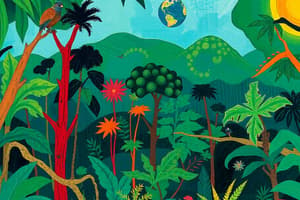Podcast
Questions and Answers
What is the temperature range typically found in tropical rainforests?
What is the temperature range typically found in tropical rainforests?
The temperature range is typically between 21°C and 30°C.
How much rainfall do tropical rainforests receive annually, and what percentage of this comes from tree evaporation?
How much rainfall do tropical rainforests receive annually, and what percentage of this comes from tree evaporation?
Tropical rainforests receive between 200 to 1,000 centimeters of rainfall annually, with about 75% coming from tree evaporation.
What role do the different layers of the rainforest play in maintaining ecological balance?
What role do the different layers of the rainforest play in maintaining ecological balance?
The layers interact and depend on each other, influencing conditions for species residing in other layers.
Why is the Amazon rainforest significant in terms of biodiversity?
Why is the Amazon rainforest significant in terms of biodiversity?
What essential functions do rainforests provide that benefit both the environment and human well-being?
What essential functions do rainforests provide that benefit both the environment and human well-being?
What percentage of the world's oxygen is produced by rainforests, and how does this contribute to ecological balance?
What percentage of the world's oxygen is produced by rainforests, and how does this contribute to ecological balance?
Describe the role of rainforests in carbon dioxide management and its significance in combating climate change.
Describe the role of rainforests in carbon dioxide management and its significance in combating climate change.
Identify two types of natural resources provided by rainforests that are essential for human well-being.
Identify two types of natural resources provided by rainforests that are essential for human well-being.
What is the significance of the 1% statistic regarding the medicinal properties of rainforest plants?
What is the significance of the 1% statistic regarding the medicinal properties of rainforest plants?
Explain how rainforests contribute to the maintenance of the water cycle.
Explain how rainforests contribute to the maintenance of the water cycle.
Flashcards are hidden until you start studying
Study Notes
Tropical Rainforest Overview
- Tropical rainforests thrive in warm, humid regions near the equator, specifically between the Tropic of Cancer (25.5°N) and the Tropic of Capricorn (23.5°S).
- Key locations include Southeast Asia, India, Australia, Africa, Central and South America, and New Guinea.
- Characterized by consistent temperatures between 21°C and 30°C, high humidity levels (77% to 88%), and substantial rainfall ranging from 200 to 1,000 centimeters annually.
- About 75% of rain is contributed from trees through their own water evaporation.
Biodiversity and Notable Rainforests
- Tropical rainforests represent the most biodiverse terrestrial ecosystems on Earth.
- The Amazon rainforest is the largest, hosting approximately 40,000 plant species, 427 mammal species, 1,300 bird species, 3,000 fish species, and 2.5 million insect species.
Structural Layers of Rainforests
- Emergent Layer: Features the tallest trees that receive maximum sunlight.
- Canopy Layer: Acts as a dense, green roof formed by tree branches, allowing for abundant sunlight.
- Understory Layer: Contains smaller vegetation that thrives in shade and high humidity.
- Forest Floor: Characterized by darkness and dampness, covered with decomposing organic material.
Ecological and Climate Regulation
- Rainforests are crucial for ecological balance, covering approximately 1.2 billion hectares worldwide.
- Contribute to climate regulation and produce around 20% of the world's oxygen.
- Serve as significant carbon dioxide reservoirs, mitigating greenhouse gas effects.
- Play an essential role in the global water cycle, returning over 50% of precipitation to the atmosphere.
Human Benefits from Rainforests
- Provide vital natural resources, including hardwood for construction (e.g., teak, rosewood) and various fibers for furniture and products.
- Source of numerous foods, such as spices (cinnamon, vanilla), fruits (bananas, mangoes), and staple items like cocoa and coffee.
- A quarter of natural medicines originate from rainforests; plants contribute to cancer treatment, with 70% of effective treatments discovered here.
- Only 1% of rainforest plant species have been studied for medicinal properties, indicating vast potential for medical discoveries.
Threats to Rainforests
- Rapid industrialization has led to significant rainforest depletion and destruction in recent centuries.
Studying That Suits You
Use AI to generate personalized quizzes and flashcards to suit your learning preferences.




